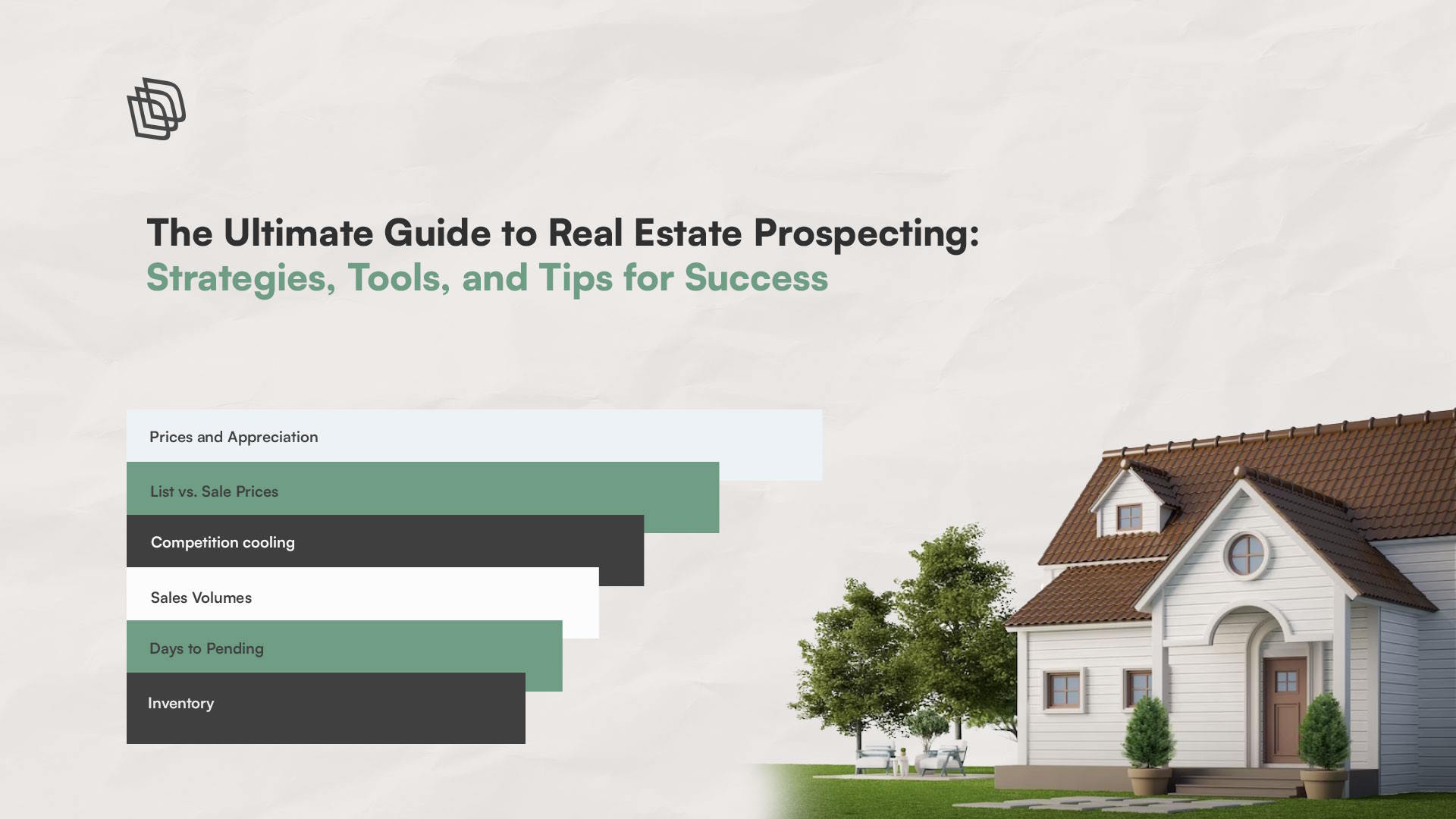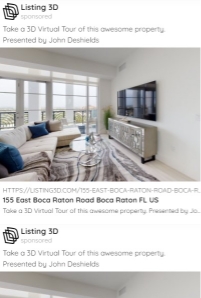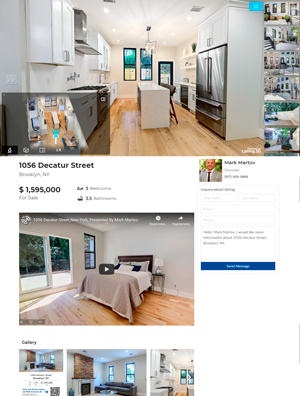The Ultimate Guide to Real Estate Prospecting: Strategies, Tools, and Tips for Success

The Evolving Real Estate Landscape: A Data-Driven Approach to Connecting with Homeowners
The real estate market is experiencing an interesting phase of continued yet decelerating growth amidst global uncertainty. While the days of bidding wars and soaring home valuations may be cooling off, data indicates the housing market retains underlying strength. Well-priced, desirable listings in competitive markets still sell quickly. However, more moderate appreciation and longer listing times signal a shift toward balancing the scales between buyers and sellers.
Navigating the nuances of this evolving landscape requires real estate professionals to take an agile, data-driven approach. Armed with the right insights, agents can capitalize on opportunities to benefit homeowners looking to buy or sell. The human touch remains integral, but augmenting connections with predictive analytics and market intelligence helps ensure optimal outcomes.
This article will analyze current housing data and trends, strategies for leveraging technology to identify promising leads, crafting effective outreach, overcoming objections, and ultimately building trust with homeowners.
Key Real Estate Market Observations
- Prices and Appreciation: The Zillow Home Value Index indicates home values are still appreciating positively year-over-year, up 1.33% nationally to $351K in August 2022. However, the monthly change slowed to just 0.23%, down from 0.68% the previous month. This points to a continued yet more moderate price trajectory.
- List vs. Sale Prices: While median list prices remain high, actual sale prices are softening. The median list price in August was $395K, up 1.31% YoY. However, July’s median sold price was $365K, down 0.82% monthly and nearly 8% YoY. The growing gap between listings and sales suggests pricing adjustments are occurring.
- Competition cooling: The share of homes selling above list price fell 1.2 percentage points between June and July to 40.4%. This could reflect easing competition, though still historically high.
- Sales Volumes: Only 267,000 homes sold in July, nearly 23% below pre-pandemic activity. This slowdown is likely due to high mortgage rates deterring buyers and low inventory. However, new listings picked up 4% from July to August, potentially signaling more supply ahead.
- Days to Pending: Despite slower sales, homes are selling swiftly. Properties averaged just 13 days from listing to pending in August compared to 26 days pre-pandemic. This indicates an advantage for well-positioned sellers.
- Inventory: Active listings fell 13.94% YoY in August 2022, leaving under 1 million homes on the market. With supply lagging demand, sellers retain leverage in most markets.
The data shows a complex picture – appreciation is tapering but still positive, prices are high though softening, competition is cooling slightly but inventory remains constrained. This suggests opportunities exist for savvy agents and clients who understand their local market intricacies and wisely position themselves for success.
Leveraging Predictive Analytics to Identify Promising Leads
In today’s shifting real estate environment, agents require an edge to pinpoint homeowners likely to list soon and deliver value. Predictive analytics offers this advantage by analyzing market trends, economic factors, property records, and consumer behavior to identify probable leads. Powerful AI algorithms process vast datasets most agents lack time to compile and interpret manually.
The analytics unearth non-obvious indicators that a particular homeowner may sell, based on factors like:
- Comparable home valuations and sales activity in the neighborhood
- Renovation permits on the property
- The owner’s age, housing tenure, life stage
- Online search behavior and site visitors
- Equity built in the home
By detecting patterns across millions of data points, the algorithms can isolate homeowners with a high probability of selling. This enables agents to target outreach efficiently, saving time chasing unqualified leads. The analytics essentially do the heavy data lifting so agents can focus on building meaningful connections.
Conveying the value to homeowners requires simplifying the narrative around what otherwise seems like a “black box” process:
- Explain it analyzes market trends, not personal data
- Emphasize it flags opportunities, not sales pitches
- Clarify predictions based on aggregate data, not invasion of privacy
- Reinforce that the human relationship still drives everything
Once prospects understand the predictive technology seeks to help, not hassle them, they tend to receive recommendations more openly.
Crafting Connections Through Effective Outreach
Armed with promising leads, the next challenge is making inroads with skeptical homeowners through outreach. Cold calling presents obstacles from initial distrust to overcoming objections. Authenticity, empathy and adding value should drive the conversation, not aggressive salesmanship.
Here are approaches for maximizing the likelihood of positive engagements:
Greeting:
- Warm, personable introduction with agent’s full name.
- Clear purpose stated upfront – calling about a housing opportunity for them.
- Permission requested for their time and attention.
Explanation of Reason for Outreach:
- Disclose identified through predictive analytics, not a sales gimmick.
- Emphasize Flagging a potential advantageous situation for them, not pitching services.
- Reassure confidentiality and that it’s an educational call, no pressure.
Addressing Objections:
- Actively listen and validate concerns to build trust and rapport.
- Present insights and solutions, don’t dismiss objections.
- Ask thoughtful follow-up questions to better understand needs.
Adding Value:
- Offer useful market stats and projections to inform their decisions.
- Provide relevant housing materials with no strings attached.
- Discuss pros/cons of timing a sale or purchase in the current market.
- Build goodwill by sending area comparables, value estimates, listing options overview.
- Frame it as equipping them with helpful data.
Closing the Loop:
- Gauge interest level in discussing further in-person.
- If interest, move to schedule meeting and outline next steps.
- If not ready, nurture lead by staying top of mind through occasional, valuable content.
- Thank them for their time and keep door open for future.
This consultative approach aims to develop a relationship of trust and rapport. Once prospects see the outreach is about understanding their needs rather than strong-arming a sale, they tend to open up.
Handling Common Homeowner Objections
Despite best efforts, objections will still arise. How an agent responds can make or break the possibility of winning business down the road. Some examples of frequent objections and effective counterpoints:
Objection: “Now’s not a good time to sell with the market slowing.”
Objection: “Now’s not a good time to sell with the market slowing.”
Response: “There are pros and cons in any market. I can help you optimize pricing and strategy tailored to current conditions to maximize your sale outcome.”
Objection: “I want to try selling it myself.”
Response: “FSBOs can certainly work, though data shows sellers net about 16% more on average when collaborating with an agent. I offer flexible packages to meet different needs and budgets.”
Objection: “My home needs too many repairs and upgrades before listing.”
Response: “Some improvements add value while others don’t sufficiently boost price to justify the costs. I’m happy to analyze the ROI on specific upgrades to help avoid overspending.”
Objection: “Mortgage rates need to come down before I can buy.”
Response: “Rates fluctuate but are expected to remain between 7-8% absent an economic crisis. Rather than waiting indefinitely, let’s evaluate what monthly payment works for your budget in today’s market.”
The art is hearing homeowners out, validating concerns, and guiding the conversation positively. Eventually prospects realize agents aim to help, not badger them.
Building Rapport and Trust with Homeowners
Outreach represents the first touch, but the real work of building relationships comes through authentic rapport. Making emotional connections and earning trust should be the priority over hard selling.
Some principles for nurturing this vital foundation:
- Demonstrate understanding of the property’s personal meaning through active listening.
- Convey empathy regarding anxieties around major financial decisions.
- Ask thoughtful questions to understand motivations and goals.
- Provide tailored insights versus generic market data.
- Position yourself as an advisor guiding them, not pushing them.
- Follow through reliably on promises and commitments.
- Focus on informing and assisting, not just closing deals.
- Express appreciation for their time and perspective.
- Follow up consistently without being overbearing.
When homeowners feel their agent truly cares about making the process smooth for them personally, they end up being the best promoters and sources of referrals as well. But it takes patiently earning that trust.
Continuously Improving Outreach with Data
Finally, data should fuel the quest for constantly improving outreach and engagement. Recording call outcomes, client feedback, and market response provides intelligence agents can use to refine techniques.
Analytics like call conversion rates, hot lead indicators, and customer satisfaction levels help quantify what resonates or falls flat. Training programs can then leverage this data to role-play effective scenarios and responses.
Ongoing analysis of market shifts also allows outreach messaging to adapt accordingly. As the housing landscape evolves, so too should consultative sales skills and objections handling.
In conclusion, real estate agents must embrace analytics and emotional intelligence in tandem to thrive amidst fluctuating conditions. Data guides them to promising opportunities while empathy and trust drive conversions. Maintaining genuine connections and adding value is ultimately what sets successful agents apart.
Real estate agents can face difficulties in a low inventory market, but there are strategies they can employ to succeed. It’s important to stay up-to-date on the market, prioritize listings, work with buyers, build relationships with other agents, be innovative with financing options and use cutting-edge technologies to stand out during the listing presentation, and focus on cultivating long-term relationships with clients. By implementing these tactics, agents can thrive even in challenging market conditions. Overwhelmed and looking for some help? Listing3D has got you covered. Schedule a demo with us.
Additional Services
Take Your Marketing Even Further






Additional Features at no cost
Part of any package












